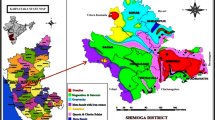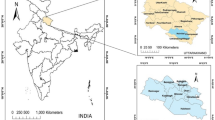Abstract
The purpose of the present study is to assess dose received by individual tissues or organs of human beings from the exposure of indoor radon (Rn-222), thoron (Rn-220) and their progeny concentrations using single entry pinhole dosimeters and deposition based progeny sensors (DRPS/DTPS). The deployment of dosimeters were carried out in 75 dwellings across Hanumangarh district of Rajasthan, India. Annual and seasonal activity concentrations were monitored based on which dose distribution to various tissues and organs were assessed. The estimated average annual effective dose of the study area is 0.8 mSvy−1, which is lower than the ICRP recommended limit of 4 mSvy−1 (at work place) and 14 mSvy−1 (for residential buildings) (International Commission on Radiological Protection (ICRP) in Radiological protection against radon exposure, ICRP, Stockholm, 2018). Consequently, indoor radon may pose no health risk to the local population of the studied area.








Similar content being viewed by others
References
International Commission on Radiological Protection (ICRP) (2018) Radiological protection against radon exposure. ICRP Publication ref 4836-9756-8598. ICRP, Stockholm, Sweden
WHO (2009) Handbook on indoor radon: a public health perspective. World Health organization, Geneva, Switzerland (ISBN: 978 92 4 154767 3)
Milner J, Shrubsole C et al (2014) Home energy efficiency and radon related risk of lung cancer: modelling study. BM 348:1–12
Dowdall A, Murphy P et al (2017) Update of Ireland’s national average indoor radon concentration-application of a new survey protocol. J Environ Radioact 169–170:1–8
Nazir S, Simnani S et al (2020) Continuous radon measurements at high altitude physics observatory, Gulmarg, Kashmir valley, J&K, 4. https://doi.org/10.17632/vdzpw2hsbb.4
United Nations Scientific Committe on effects of Atomic Radiation (UNSCEAR) (1994) United Nations, New York
Chauhan RP, Kumar A, Chauhan N, Joshi M, Aggarwal P, Sahoo BK (2016) Ventilation effect on indoor radon–thoron levels in dwellings and correlation with soil exhalation rates. Indoor Built Environ 25:203–212
Mehra R, Bhagotra P, Kaur K (2015) 222 Rn and 220 Rn levels of Mansa and Mukutsar district of Punjab, India. Front Environ Sci 3(37):1–7
International Atomic Energy Agency (IAEA) (1989) Facts about low level radiations, IAEA/PI/A9E 85-00740. American Nuclear Society, Washington, DC
Kansal S, Mehra R, Singh NP (2011) Measurement of indoor radon concentration in the dwellings of Western Haryana, India, for health risk assessment. Int J Low Radiat 8(2):122–134
Khan FM, Gibbons JP (2014) Khan’s the physics of radiation therapy, 5th edn. Lippincott Williams & Wilkins, Philadelphia
Folger PF, Nyberg P et al (1994) Relationship betweern Rn222 dissolved in groundwater supplies and indoor Rn222 concentration in some Colorado front range houses. Health Phys 67:245–253
Beir VI (1999) Report of the committee on the biological effects of ionizing radiation: health effects of exposure to radon. Natl. Res. Council. Acad. Press, Washington
Mehra R, Singh S, Kumar S (2009) Measurement of indoor radon levels in dwellings of Sirsa District, Haryana and estimation of average annual dose. J Environ Sci Engg 51(2):103–106
Beir IV (1988) Report of the committee on the biological effects of ionizing radiation: health risks of radon and other internally deposited alpha emitters. Natl. Res. Council. Acad. Press, Washington
Sonkawde RG, Ram R et al (2003) Radon in tube-well drinking water and indoor air. Indoor Built Environ 13:383–385
Mishra R, Mayya YS (2008) Study of deposition-based direct thoron progeny sensors (DTPS) technique for estimating equilibrium equivalent thoron concentration (EETC) in indoor environment. Radiat Meas 43:1408–1416
Pyngrope A, Khardewsaw A et al (2020) Study of indoor radon, thoron and their progeeny in South West Khasi Hills District of Meghalaya. India Radiat Prot Dosim 189(3):347–353
Tsiyoglou EC, Ayer HE, Holaday DA (1953) Occurence of nonequilibrium atmospheric mixture of radon and its daughters. Nucleonics 11(9):40
Mayya YS, Mishra R (2010) Wire-mesh capped deposition sensors: novel passive tool for corse fraction flux estimation of radon thoron progeny in indoor environments. Sci Total Environ 409:378–383
Henshaw DL, Eatough JP, Raichanderson RB (1990) Radon as a causative factor in induction of myeloid leukemia and other cancers. Lancet 355:1008–1015
Krewski D, Lubin JH et al (2005) Residential radon and risk of lung cancer a combined analysis of 7 North American case control studies. Epidemiology 16(2):137–145
Kansal S, Mehra R et al (2014) Assessment of indoor radon concentration in air using RAD7 and radon exhalation rate measurement in soil samples. J Appl Phys 5(2):80–84
Hill DSD et al (2004) Radon in homes and risk of lung cancer, collaborative analysis of individual data from 13 European case-control studies. Br J Cancer 330:223
Lubin JH, Boice JD et al (1995) Lung cancer in radon-exposed miners and estimation of risk from indoor exposure. J Natl Cancer Inst 87(11):817–827
Lubin H, Boice JD (1997) Lung cancer risk from residental radon: meta analysis of eight epidemological studies. J Natl Cancer Inst 89:49–57
Sahoo BK, Nathwani D (2007) Estimation of radon emanation factor in Indian building materials. Radiat Meas 42(8):1422–1425
Hassan NM, Tokonami S, Fukushi M (2011) A Simple technique for studying the dependence of radon and thoron exhalation rate from buildiong materials on absolute humidity. J Radional Nucl Chem 287:185–191
Soh T, Saidu et al (2019) Simultanous measurements of indoor radon and thoron and inhalation dose assessment in Douala city, Cameroon. Isot Environ Health Stud 55(5):499–510
Saini K, Sahoo BK, Bajwa BS (2018) Estimation of indoor radon, thoron and their decay products concentration along with annual inhalation dose in dwellings of Punjab, India. Indoor Built Environ 27:380–389
Nikolopoulos D, Louizi A (2008) Study of indoor radon and thoron in drinking water in Greece and Cyprus: implication to exposure and dose. Radiat Meas 43:1305–1314
Chen J, Bergman L et al (2015) Results of simultaneous radon and thoron measurements in 33 Metropolitan areas of Canada. Radiat Prot Dosim 163(2):210–216
Epinosa G, Golzarri JI et al (1999) Distribution of indoor radon levels in Mexico. Radiat Meas 31:355–358
Nguyen-Thuy D, Van Nguyen H et al (2019) 220Rn (thoron) geohazard in room air of earthern dwellings in Vietnam. Geofluids. https://doi.org/10.1155/2019/7202616
Mirbeg A, Poursani AS (2018) Indoor radon measurement in residential/commercial buildings in Isfahan city. J Air Pollut Health 3(4):209–218
Hussein ZA, Jaafar MS, Ismail AH (2013) Measurement of indoor radon concentration levels in Iraqi Kurdistan region. Arch Appl Sci Res 5(2):72–78
Hussanvand H, Birjandi M et al (2019) Investigation of indoor radon concentration in dwellings of Aleshter (Western part of Iran) and estimation of the annual effective dose from exposure to radon. Int J Radiat Res 17(4):659–666
Al-Saleh FS (2007) Measurement of indoor gamma radiation and radon concentration in dwellings of Riyadh city, Saudi Arabia. Appl Radiat Isot 65:843–848
Sahoo BK, Sapra BK et al (2013) A new pinhole discrimenated 222 Rn/220 Rn passive measurement device with single entry face. Radiat Meas 58:52–60
Nazir S, Simnani S et al (2020) Dose estimation of radioactivity in groundwater of Srinagar City, Northwest Himalaya, employing fluorimetric and scintillation techniques. Environ Geochem Health 1:18
Singh B, Kant K et al (2018) A comparative study of radon levels in underground and surface water of Faridabad district of Southern Haryana, India. J Radioanal Nucl Chem 319(3):907–916
Kaur M, Kumar A, Mehra R, Mishra R (2017) Assessment of attached and unattached progeny concentrations of 222Rn/220Rn and their contribution to dose using deposition-based progeny sensors. Environ Earth Sci 76(16):1–12. https://doi.org/10.1007/s12665-017-6874-4
Eappen KP, Sahoo BK et al (2008) Calibration factor for thoron estimation in cup dosimeter. Radiat Meas 43(1):S418–S421
Ramola RC, Parshad M et al (2016) Dose estimation derived from the exposure to radon, thoron and their progeny in the indoor environment. Sci Rep 6:31061
Kumar A, Chauhan RP et al (2014) Implications of variability in Indoor radon/thoron levels: a study of dwellings in Haryana, India. Environ Earth Sci. https://doi.org/10.1007/s12665-014-3688-5
Singh P, Saini K et al (2016) Attached, unattached fraction of progeny concentration and equilibrium factor for dose assessment for radon and thoron. Radiat Environ Biophys 55:401–410
Singh B, Kaint K et al (2019) A study of seasonal variations of radon, thoron and their progeny levels in different types of dwellings in Faridabad district Southern Haryana India. J Radioanal Nucl Chem 320(3):841–857
Mishra R, Sapra BK, Mayya YS (2014) Multi parametric approach towards the assessment of radon and thoron progeny exposure. Rev Sci Instrum. https://doi.org/10.1063/1.4865165
UNSCEAR 2008 Report: Sources and effects of ionizing radiation, Volume II, United Nations, New York, 2011 (e-ISBN-13: 978-92-1-054482-5)
Mishra R, Mayya YS, Kushwaha HS (2009) Measurement of 220Rn/222Rn progeny deposition velocities on surfaces and their comparison with theoretical models. J Aerosol Sci 40(1):1–15. https://doi.org/10.1016/j.jaerosci.2008.08.001
United Nations Scientific Committee on the Effects of Atomic Radiation (UNSCEAR) (2000) Annex B: exposures from natural radiation sources. United Nations, New York
NCRP (1993) Limitation of exposure to ionisation radiation. Report No. 116. National Council on Radiation Protection and Measurements, Bethesda
United Nations Scientific Committee on the Effect of Atomic Radiation (UNSCEAR) (2006) Report A/AC.82/644, exposures of workers and the public from various sources of radiations. United Nations, New York
Nazir S, Simnani S et al (2020) Simultanous measurements of radon, thoron and their progeny for inhalation dose assessment in indoors of Srinagar, J&K, India. J Radioanal Nucl Chem 325:315–328
Nazir S, Simnani S, Sahoo BK, Mishra R, Sharma T, Masood S (2020) Monitoring geothermal springs and groundwater of Pir Panjal, Jammu and Kashmir, for radon contamination. J Radioanal Nucl Chem 326(3):1915–1923
Acknowledgements
We appreciate the prodigious efforts of Supriya Rani for her expeditious support to carry out field investigation. The authors express gratitude to the editor and the two anonymous reviewers for their comments on the earlier version of the manuscript. We are also highly thankful to our project collaborator Sandeep Kanse for providing valuable inputs from time to time. A sincere thank you to Shahidah Akbar for her diligent proofreading of this manuscript.
Author information
Authors and Affiliations
Contributions
Amit Kumar Singla and Sandeep Kansal designed the research plan and wrote the manuscript with contributions from Rohit Mehra. Amit Kumar Singla carried out all the radioactive surveys and analysis. All authors read and approved the final manuscript.
Corresponding author
Ethics declarations
Conflict of interest
On behalf of all authors, the corresponding author states that there is no conflict of interest.
Additional information
Publisher's Note
Springer Nature remains neutral with regard to jurisdictional claims in published maps and institutional affiliations.
Rights and permissions
About this article
Cite this article
Singla, A.K., Kansal, S. & Mehra, R. Dose distribution to individual tissues and organs due to exposure of alpha energies from radon and thoron to local population of Hanumangarh, Rajasthan, India. J Radioanal Nucl Chem 327, 1073–1085 (2021). https://doi.org/10.1007/s10967-021-07604-3
Received:
Accepted:
Published:
Issue Date:
DOI: https://doi.org/10.1007/s10967-021-07604-3




